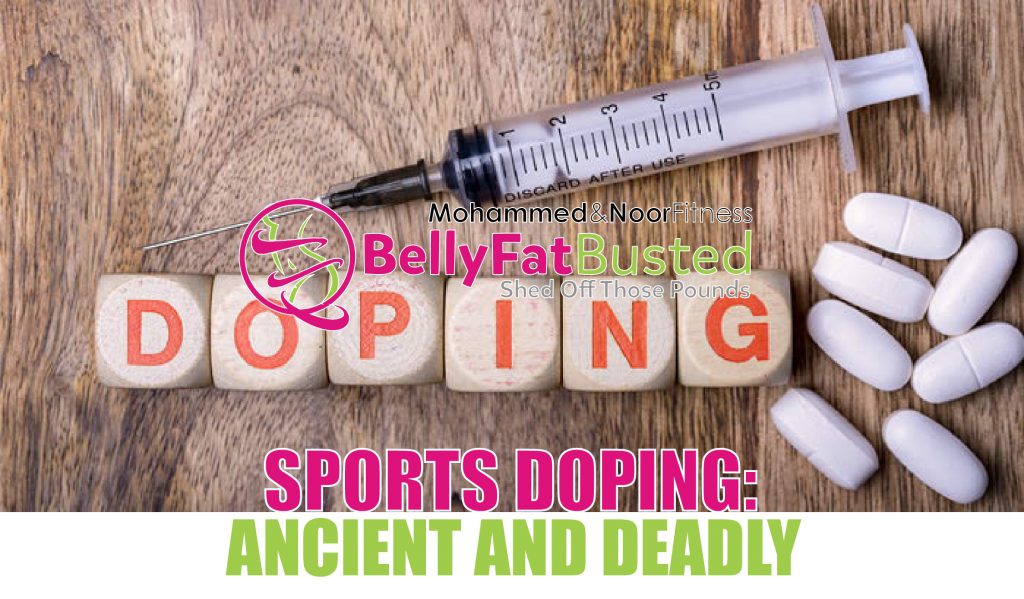
In the late 1990s, Sports Illustrated asked Olympic athletes a variation of the Goldman’s dilemma: If you were given a performance enhancing substance, and guaranteed that you would win and not be caught, would you take it?
More than 98% responded, “Yes.”
More disturbingly, when asked, “If you were given a performance enhancing substance, and guaranteed that you would win all competitions for 5 years without getting caught, but then die, would you take it?” More than half said they would.
This all-consuming will to win isn’t limited to elite athletes. We all like going home with the gold, and a serious amateur cyclist, runner, or Crossfit competitor can become as obsessed with finishing first as a professional athlete. And with shady supplements, including steroids, available with a few clicks of the mouse, there’s little to stop a determined cheat.
But accolades for a high finish in the local Century or Half-Marathon will be cold comfort if your heart, liver, kidneys, or brain spring a leak.
“Sometimes the products (sold online) are purchased for their label claims, such as ‘miracle cures,’ weight loss guarantees, sexual enhancement, or specific claims of enhanced athletic ability,” says Liz Nowland-Margolis, a spokesperson for NSF (National Sanitation Foundation) International, an independent, third-party certification body that works with supplement makers to ensure that what’s on the label is in the product. “Generally those types of unrealistic claims mean that the consumer should beware.” Bottom line: If it sounds too good to be true, it usually is, and it may even pose serious health and safety risks if consumed.
“Buying drugs on the internet is like scoring drugs at a concert,” says Steve Edwards, VP of Fitness & Nutrition at Beachbody. “You have no actual idea of what you’re getting and chances are it’s dangerous or at least junk. When professional athletes use Performance Enhancing Drugs (PEDs), they’re almost always through a personal connection. It may not be a doctor, though it often is, but they’re at least using someone who can vouch for what they’re taking.”
Purchasing supplements — online or elsewhere — isn’t quite as risky, but it can still be difficult to know exactly what you’re really buying, making organizations like NSF important. Any supplement with an NSF Certified for Sport stamp has been completely screened for athletic banned substances.
“NSF certification means that what’s on the label is what you’re getting,” says Edwards. “There have been numerous cases where athletes have failed drug tests who’ve only taken supplements. The industry has been famously unregulated and having the NSF is a huge plus, not just for athletes but for all consumers.”
“It’s important to note,” he adds. “That supplements and drugs are not the same thing. Even with decades of no regulation, there are only a handful of supplements deaths, and all of those involved extreme behavior, whereas pharmaceutical doping has led to hundreds of known deaths, and likely many more. These lines get blurred because many supplements are banned until proven safe, which is often more for political than safety reasons.”
If you’re familiar with the World Anti-Doping Agency’s (WADA) banned list, you know that it’s lengthy and, some argue, nitpicky. Not everything on it will kill you — in fact a lot of it is no more dangerous than a cup of coffee (which was once on their list) — but even if you’re not injecting EPO, do you really want to look in the mirror and see that guy, the one who cheated to win a local 10k?
***
Sport doping is hardly new. As far back as historic records of sport go, there’s corresponding evidence of athletes drugging up to do better. Notes Paul Dimeo, a lecturer on drugs in athletics at the University of Stirling, “Drugs made sport, whether we like it or not.”
It was feats of strength and endurance made possible by doping that early on turned sports like cycling and distance running from fringe events into something millions now follow and participate in. Even today, intrigue around whether a winning athlete is “on juice” helps fan global interest. “Conspiracy theories and the tales of dirty tricks and lying underpin the global attraction of elite sports competitions,” Dimeo argues.
So just how far back does it stretch? In Foul Play: The Dark Arts of Cheating in Sport, author Mike Rowbottom notes that if you consider warfare as a sort of ultimate athletic competition, then Scandinavian mythology has a pretty good candidate in the Berzerkers.
Hopped up on a drink made from Amanita muscaria mushrooms, Berzerkers worked themselves into a nearly uncontrollable, trance-like fury before battle (where the word ‘berserk’ comes from) that made ‘roid rage look like a fit of pique. It also massively increased their strength. Berzerkers, “went without their mailcoats and were mad as hounds or wolves, bit their shields… they slew men, but neither fire nor iron had effect upon them.”
Further south in Greece, ancient Olympic athletes ate lizard meat, chewed on raw animal testicles, guzzled wine potions, and used hallucinogens in search of a performance edge. And in Rome, gladiators competing before up to 60,000 spectators drank herbal infusions to strengthen them before chariot races (and perhaps to ease pre-race jitters from pondering the collision of wood, metal, and screaming horseflesh).
Far from forbidden, it was expected that short of fixing matches, a professional athletes would do whatever it took to win. What’s changed, therefore, is not the practice of sports doping, but the science. And doping as we know it today really took off with the rise of the chemicals industry in the 19th and early 20th centuries.
In 1807, Abraham Wood copped to using laudanum to stay awake during a 24-hour walk race against fellow Briton Robert Barclay Allardyce. By 1877, such races had stretched to more than 500 miles, prompting one local newspaper to chide, “It may be an advantage to know that a man can travel 520 miles in 138 hours, and manage to live… though we fail to perceive that anyone could possibly be placed in a position where his ability in this respect would be of any use.”
Useful or not, spectators loved it and promoters soon introduced similarly grueling matches to the world of cycling. “A tired walker, after all, merely sits down,” noted one organizer. “[A] tired cyclist falls off and possibly brings others crashing down as well. That’s much more fun.”
It wasn’t long before cyclists added Vin Mariani, ‘the wine for athletes,’ to their race supplies. A mixture of coca leaf extract and Bordeaux wine, it was used by French cyclists to fight off fatigue and hunger brought on by prolonged exertion.
In the 1904 Olympics, marathon runner Thomas Hicks nearly died after consuming a mixture of brandy and strychnine provided by his coach. Indeed, until cocaine and heroin were made prescription-only in the 1920s, team trainers would develop and administer their own secret narco-cocktails to help bring in a win.
Eventually, regulators started to catch up. The International Association of Athletics Federation (IAAF) in 1928 was the first body to try to stop athlete doping. But taking their lead from the military, which issued uppers to soldiers in World Wars I, II, and beyond, athletes continued to juice.
Somehow it’s not surprising that Nazi Germany went for doping in a big way. German soldiers were given testosterone to encourage aggression in battle, and the Fuhrer’s scientists are reported to have tested anabolic steroids on prisoners, members of the Gestapo, and even on Hitler himself. Examining his end-of-life behavior retrospectively, one physician said it shares several characteristics of heavy steroid use: mood swings, paranoia, and excessive aggressiveness. (Incidentally, one of the all-time great Hitler jokes treads these same waters: Why didn’t Hitler drink tequila? It made him mean.)
Lest Americans feel too superior, it’s worth noting that when the first anabolic steroid was approved by the U.S. Food and Drug Administration in 1958, its creator, Dr. John Bosley Zieglar, acknowledged it was largely to help U.S. Olympic weightlifters compete against their Russian counterparts. (Witnessing its eventual abuse, Zieglar would in later years say he wished he’d never invented the stuff.)
A series of doping-related deaths, including high-profile events like the Olympics and the Tour de France, led to the first drug testing at the 1968 Olympic games. That sent a message to athletes and countries alike that officials were serious, there was no turning back, and other major athletic bodies would likely follow suit.
Which didn’t really change anything. Fewer than a half-percent of Olympic athletes tested since then have typically been found in violation. A full 1 percent of those at the Salt Lake City winter games of 2002 failed, but much of that was attributed to snowboarders (a new Olympic sport with a history of marijuana use) getting dinged for weed, which is almost an anti-PED. With many athletes now coming clean about never failing tests despite doping-filled careers, it’s hard to put too much faith in the system. “Athletes adjust doping practices based on the technology we bring out of the labs,” Dr. Daniel Eichner, lead researcher at Sports Medicine Research Labs, told Wired Magazine in 2012. “We make an improvement, they make an adjustment, and we go from there.”
A particularly awkward episode occurred at the 1983 Pan American Games when organizers sprung surprise drug tests on those taking part. A dozen U.S. athletes immediately withdrew from competition, and another dozen or so from other countries likewise left without explanation. (For his part, one cheeky American discus thrower said it was simply a “big coincidence” that he pulled out just as testing was announced.)
But even as testing became the norm in the 1980s and 90s, athletes found loopholes and ways to beat the tests. Hand it to Irish swimmer Michelle Smith for at least showing a sense of humor. A urine sample she provided testers in 1998 contained a lethal dose of ethanol, leading forensic experts to determine she’d poured straight whiskey into her pee to try to hide any traces of performance enhancing drugs.
Three particularly high-profile cases have in recent decades come to symbolize high-stakes sports doping and the ignominy that comes with getting caught.
In 1988, Canadian sprinter Ben Johnson was stripped of his gold after testing positive for the anabolic steroid stanozolol. Though he claimed his drink had been spiked, two books have been written alleging PED use by his Canadian team. Johnson was later banned for life after he failed another test.
In 1992, one of the first major campaigns against PED use was started by football player Lyle Alzado, who claimed a lifetime of steroid abuse had led to the cancer he was dying from. While the link was never medically confirmed, he was the first professional athlete to publically come clean about the rampant use of PEDs in sports.
In spite of this, the 90s saw some of the biggest offenses in history. Baseball “got big,” as games started to feel more like homerun derby contests — an era succinctly captured by former pro and tell-all author Jose Canseco in his books Juiced and Vindicated. Meanwhile, cycling “got fast,” thanks to a new drug, erythropoietin (EPO), causing Alpine climbs to be accomplished at such speeds that their times have yet to be eclipsed, despite huge advances in equipment.
In 1998, Major League Baseball slugger Mark McGwire broke the then single-season home run record, only to subsequently admit he’d been using steroids and a steroid precursor (one that turns into a steroid when metabolized) to help bulk up. A teary admission went over poorly as McGwire continued to insist he would have performed just as well without drugs — which was hard to swallow considering all the records that were set during that period.
Deaths during this era are hard to quantify but dozens of professional cyclists suffered heart attacks, which were generally attributed to EPO, which thickens the blood. And a few ball players have publicly stated that steroid use ruined both their careers and their health.
In what was finally a big win for the doping authorities, cyclist Lance Armstrong will for generations serve as the ultimate example of the reputational harm that can come from using and getting caught. The seven-time Tour de France winner was stripped of his medals, dropped by multi-million-dollar sponsors like Nike, and banned for life from participating in elite sports in 2012 after he declined to fight doping charges. A lame mea culpa on Oprah left fans at home and abroad shaking their heads, and painted Armstrong as a shell of his former, master-of-the-universe self.
Yet even cases like these have not stopped the practice of sports doping, and athletes and regulators at every level struggle to stay ahead of one another. It’s a whack-a-mole competition that regulators inevitably lose — you just can’t anticipate every new molecule that will flow down the pike.
Like society’s wider “War on Drugs,” hope for clean sport seems to lie in diminishing demand. Educating young athletes helps, as does a culture that sees pharmaceuticals for sports advantage as simply unsportsmanlike.
The thrill of victory? Sweet. Hell yeah. But as Johnson, Armstrong, McGwire (not to mention Alex Rodriguez, Manny Ramirez, Roger Clemens, Floyd Landis, Marion Jones, and a litany of others) can attest, having your reputation ruined is a hell of a price to pay after years of personal sacrifice and grueling training that might have gotten you the gold anyway.




Leave A Reply